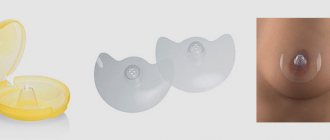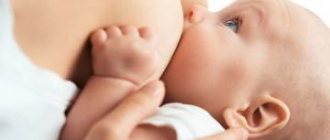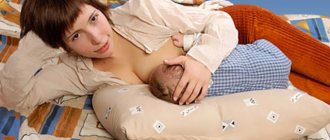Pregnant women are told that they must buy breastfeeding pads. But the opinion is wrong, because the difficulties that arise during feeding are temporary. However, there are situations when the use of such overlays is mandatory. Pregnant and nursing mothers can quickly order this type of product through our catalog, and then pick it up at one of the branches.
When their use is necessary
Sometimes a doctor prescribes breastfeeding pads, because there are a number of situations when you can’t do without them:
- For very severe pain that occurs during feeding. Especially if this was the woman’s first pregnancy. Nipple cracks heal slowly, and in combination with a low pain threshold, they can lead to the mother’s refusal to breastfeed. Therefore, in order not to switch your baby to formula, you need to use pads.
- If the baby has a short frenulum of the tongue. Because of this, his tongue takes an active part in the feeding process, but cannot properly grasp the nipple. This causes difficulty in the lactation process. Therefore, in order not to cut the frenulum, the mother uses overlays.
- If the baby belongs to the category of “special” children: born prematurely, has a weak central nervous system. In such newborns, the process of sucking and swallowing is impaired, so they do not receive enough breast milk in the required volume. But the pads help to cope with this problem and not transfer the baby to formula.
- If the baby has been drinking milk from a bottle for some time, it is likely that he will get used to the nipple and will refuse his mother's breast. In this case, a breast shield will help resume the process of breastfeeding.
In all of these situations, breastfeeding shields make lactation easier. This also allows you not to transfer the baby to artificial nutrition too early. For pregnant and nursing mothers, the price of goods in our pharmacy is low.
Do I need breast pads for breastfeeding?

Nipple shields for feeding are a proven invention over the years. The first mentions of it can be found in medical publications published four centuries ago. Then the products were used to lengthen flat nipples or to protect delicate skin from friction with clothing. But previously, the device was made from materials that could harm the baby or break quickly. Today, pads are made from silicone. Each package contains detailed instructions for using the product. GW specialists recommend familiarizing yourself with it in detail. And before purchasing, be sure to consult a doctor.
Silicone breastfeeding pads are used for a variety of reasons.
Child's refusal to breastfeed
This is possible with a long-term replacement of natural feeding with artificial feeding or after using a bottle. Milk or formula from the nipple flows continuously and does not require effort, so the baby refuses to return to the previous way of eating.
Cracked nipples
The causes of such unpleasant damage can be:
- improper attachment to the breast;
- skin diseases or thrush;
- dry and rough skin of the nipples (it must be lubricated with moisturizing creams).
For cracks associated with improper attachment, it is recommended to first try to improve the feeding technique.
Immaturity of the baby's nervous system
This problem is usually faced by mothers who gave birth prematurely. The child suckles at the breast with frequent interruptions and does not properly clasp the nipple with his mouth. Thanks to silicone nozzles, the baby learns to suck while feeding on mother's milk.
Anatomical features of the nipple structure
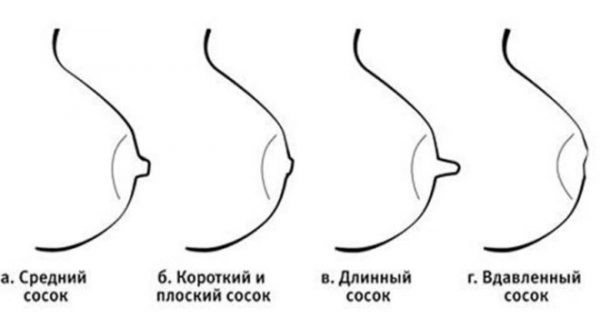
These include nipples that are too large, recessed or flat, which create discomfort for the baby when feeding. Overlays correct the shape of the nipples. But more often than not, the baby adapts to the mother’s “features” over time, and the use of silicone products can be eliminated.
Disadvantages of using them

Despite the fact that they help create comfortable conditions for a nursing mother, there are also disadvantages to their regular use:
- are addictive in mother and baby. Then the child refuses to take the mother's breast without this device. But a woman’s nipples remain hypersensitive and there is no adaptation to the natural sensations of feeding;
- the pad is made of materials that do not allow air to pass through, which can cause digestive problems in the baby;
- they need to be specially cared for and sterilized each time to avoid infection;
- overlays are impractical to use. They can tear and are inconvenient to wear outside when the need for feeding arises;
- due to little stimulation of the nipples during feeding, the amount of milk decreases.
Therefore, many experts agree that pads should be used only as a last resort.
Why do you need breastfeeding pads?
These are products made of special material that follow the shape of the nipple and are designed to protect it during natural feeding, as well as to facilitate the sucking process itself. This product is recommended in cases where breastfeeding cannot be maintained in any other way.
These pads are recommended for use in the following situations:
- When mommy's nipple is too large or flat.
- If problems arise with lactation, especially in the first days after childbirth, when cracks may occur in the nipples due to improper attachment, further feeding becomes painful. During this period, it is especially important to solve this problem, because improper latching can lead to the production of insufficient milk.
- At the birth of a premature baby who is not yet able to suckle on his own, as well as if the child, for some reason, is physically weak.
- In cases where the newborn was temporarily force-fed from a bottle and subsequently refuses to breastfeed. This device imitates a nipple, but the baby must make some effort to get milk.
- In situations where the baby has an abnormal structure of the oral cavity. A common condition is a short frenulum and it is difficult for the child to latch onto the nipple correctly.
- During teething, when the baby can bite the nipple and cause pain to the mother. Such products will help you avoid unpleasant sensations.
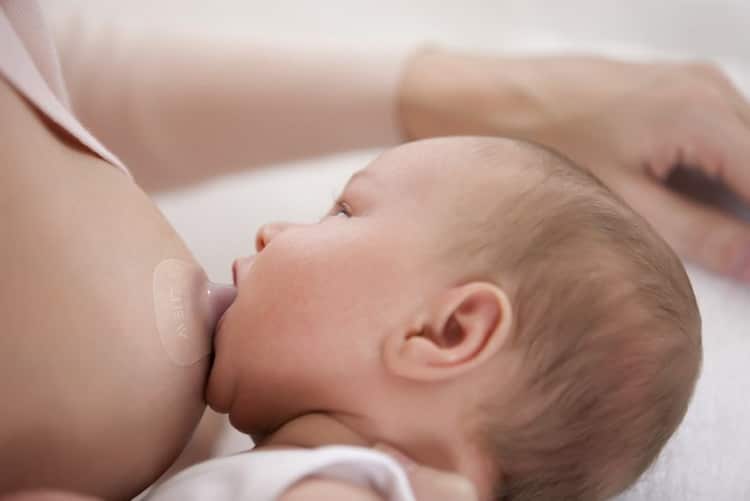
Varieties
They are divided into three groups, depending on the material used for their manufacture:
- rubber, but today such products are rare and doctors do not advise using them. Because they do not provide a proper fit, which is why some of the milk leaks out and the baby does not receive enough of it;
- Latex pads have a more pleasant tactile sensation than rubber pads. But they are also not recommended to buy, because they quickly become unusable and absorb foreign odors;
- Silicone products are the most suitable option. They are hypoallergenic and promote active stimulation of the nipple.
Today, manufacturers of products for children and nursing mothers offer a large selection of breastfeeding pads.
Trap: nipple shields
https://am-am.info/lovushka-nakladki-dlya-soskov/
Trap: nipple shields
August 17, 2008 | Category: Breastfeeding, Problems: lactostasis, ...| Author: Natalia Razakhatskaya
The first problems with breastfeeding most often begin in the maternity hospital, especially if the child is brought to the mother only “for dates.” By nature, newborns are not designed for such short periods of communication with their mother, so very often the baby begins to “rebel” with any attempt to attach him to the breast.
Inexperienced mothers begin to panic and run to doctors for advice. They, in turn, offer two standard ways to solve this problem: either express and bottle feed, or try nipple shields. It is also recommended to use breast shields for sore nipples , inverted or flat nipples .
Nipple shields are made from thin silicone or thicker latex, and they cover the nipple and areola while the mother feeds the baby.
The child eagerly begins to suck on the cover because it is easier - it sticks out better, and because it resembles the pacifier from which he was repeatedly fed while he was crying all alone in the children's department. Mom sighs with relief - finally, things are getting better, not suspecting that she is only postponing the baby’s weaning to the breast for an indefinite future and, in fact, is dealing a serious blow to breastfeeding.
The fact is that there are two problems associated with nipple shields .
The first is that when the pad is in place, the breast does not receive enough stimulation that occurs when the baby sucks directly from the breast. This in turn leads to a decrease in milk supply and weight loss in the baby.
The second is that the baby remembers how to suck on a silicone nipple and it is almost always very, very difficult to wean him off the nipple
As a rule, mothers call me with a complaint that the child hangs on the chest for a long time, often cries or, on the contrary, sleeps all the time and almost always does not gain weight well. Unfortunately, often mothers are not ready to immediately remove the pad and patiently offer the breast to the baby when he screams and spits it out. Sometimes relearning takes several days of hassle and painful attachments, but the most patient and determined are always rewarded, first of all, with the grateful eyes of a child who has finally learned what it means to really suckle.
So, if you have sore nipples or difficulty latching, don't take the easy way out and avoid breast shields. Remember that the shape of your breasts or nipples does not affect your ability to breastfeed , and the baby will agree to suckle at any breast if the mother acts competently and managed to avoid pre-breastfeeding from a bottle in the hospital.
It's better to work directly on solving the problem:
- Invite a breastfeeding consultant to show you how to properly attach your baby to the breast.
- Regain your baby’s trust: carry him as much as possible in your arms (in a sling), preferably “skin to skin”, sleep together day and night, cancel all stressful situations (trips to the clinic, visits from relatives and friends, walks, massage and etc.)
- Express milk regularly (every 3 hours) and feed your baby with a cup, spoon or pipette until he begins to latch on. To satisfy the sucking reflex, you can offer to suck your finger. Naturally, bottles and pacifiers are contraindicated.
- If there are still linings and you cannot remove them immediately, cut off the tip of the lining 1 mm every two days. In this way, the baby can gradually adapt to new conditions. But this is a last resort for those who have been feeding through a pad for more than 2 months.
Remember that only your unwavering desire to breastfeed and self-confidence is the key to solving any problems in establishing breastfeeding. Of course, there is still something you need to know about this process, but I think readers of my blog already know the basics 

How to properly care for products
The pads must be sterile because the baby comes into close contact with them. This is also necessary to ensure safety for the health of the nursing mother, because there may be cracks in the nipples. Following all care recommendations will help you avoid many problems during lactation. But frequent sterilization can lead to damage to the product.
- Before first use, it is necessary to sterilize the pad. It needs to be boiled for several minutes.
- After each feeding, it should be washed in warm, soapy water and dried.
- Products need to be boiled every other day for three minutes.
If a nursing mother has a steam sterilizer, then the process of caring for the pads is simplified. This method of treatment is gentle and can be done every day.
How to wean your child off pads
This is an important point that is worth talking about, because improper weaning can lead to the fact that the baby does not want to take the breast and he begins to refuse it, and this is detrimental to further natural feeding.
- You can start feeding your baby with the pad on and then quickly remove it. A hungry baby may not notice the change and very soon it will be possible to give him breastfeeding without any intermediaries.
- It is convenient to practice natural feeding without “helpers” at night; a sleepy and hungry baby will more easily take the breast and begin to suckle.
- You can also gradually trim the silicone in the nipple area and increase the area of the hole. The baby will get used to the nipple and you will soon be able to give him the breast without “intermediaries”.
- It is also important to spend as much time as possible with the child: carry him in your arms, talk, stroke him and give relaxing massages. The psychological aspect is important for lactation.
- Offer your baby the breast as often as possible and don’t be upset if he doesn’t take it right away. This is an adaptation process and will take time.

Recommendations for their use

Breastfeeding shields are not a must-have item that every breastfeeding mom should have. If the doctor decides that their use is necessary, then after solving the problem the baby needs to be weaned off them. To do this, the mother should put the newborn to the breast during sleep or quickly remove the device during feeding.
You can also make using the pads uncomfortable for your baby. And you shouldn’t start using them without an objective reason. If the child does not have difficulty feeding, gains weight, and the mother does not experience discomfort, then these products are not needed.
How to use nursing pads?
The manufacturer provides clear instructions for use with Contact silicone pads.
Hold the pad by the very edges with well-washed hands.
Moisten the pad with drinking water (not tap water). This will ensure a better fit.
Gently apply the breast shield to the breast so that the nipple hits the protruding part.
After use, the pad comes off easily; it should be rinsed thoroughly. The manufacturer also advises boiling the product once a day.
Attention : if the Medela silicone breast pad does not fit well or slips off during feeding, you may have chosen the wrong size.
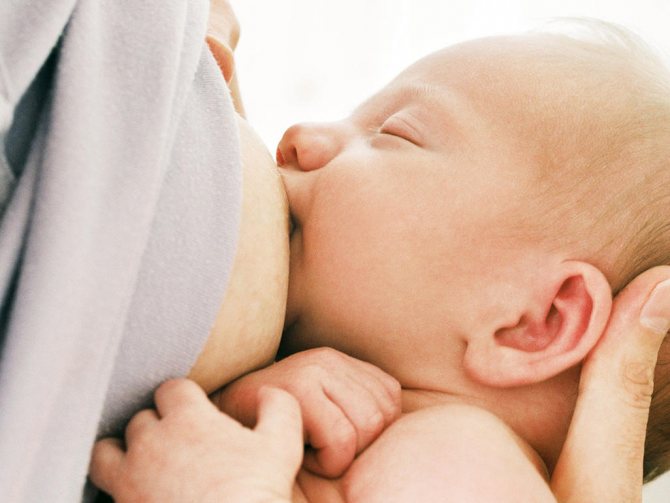
The pads come with a case in which you can store or move the accessory.
Where can I order breastfeeding pads with delivery?
You can purchase silicone pads at the online pharmacy “Aptstore”. Our network has established itself well in the pharmaceutical market thanks to high-quality products and a high level of service. The electronic catalog presents a large assortment of products for pregnant and nursing mothers from the pharmacy, including pads.
All products meet quality requirements and are safe for the baby and his mother. You can find linings from both domestic and foreign manufacturers. Another advantage of purchasing from Aptstore is affordable prices. Products come directly from manufacturers, so there is no additional markup.
